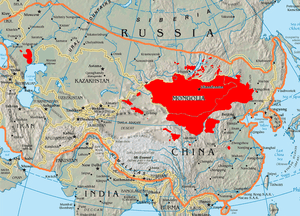Mongolian language facts for kids
Quick facts for kids Mongolian |
||||
|---|---|---|---|---|
| монгол хэл ᠮᠣᠩᠭᠣᠯ ᠬᠡᠯᠡ | ||||
| Native to | Mongolia | |||
| Region | All of state Mongolia and Inner Mongolia, parts of Liaoning, Jilin, Heilongjiang, Xinjiang and Gansu provinces in China | |||
| Native speakers | 5.2 million (2005) | |||
| Language family |
Mongolic
|
|||
| Early forms: |
Middle Mongolian
|
|||
| Standard forms |
Khalkha (Mongolia)
Chakhar (China)
|
|||
| Dialects |
Khalkha
Chakhar
Khorchin
Kharchin
Baarin
Shilin gol
Ordos Mongolian
Darkhad
|
|||
| Writing system | Mongolian alphabets: Traditional Mongolian script (in China), Mongolian Cyrillic alphabet (in Mongolia), Mongolian Braille |
|||
| Official status | ||||
| Official language in | Mongolia China Inner Mongolia |
|||
| Regulated by | Mongolia: State Language Council, China: Council for Language and Literature Work |
|||
| Linguasphere | part of 44-BAA-b | |||

Geographic distribution of Mongolic peoples across Asia (red)
|
||||
|
||||
The Mongolian language (![]() , Mongɣol kele, Cyrillic: Монгол хэл, Mongol khel) is the best-known member of the Mongolic language family and the language of most of the residents of Mongolia, where it is officially written with the Cyrillic alphabet and of around three million Mongolian speakers in the Inner Mongolia Autonomous Region of China, where it is officially written with the traditional Mongolian script. It is also spoken in some areas in the Russian Far East and Kyrgyzstan. The majority of speakers in Mongolia speak the Khalkha (or Halh) dialect, while those in China speak one of many Inner Mongolian dialects.
, Mongɣol kele, Cyrillic: Монгол хэл, Mongol khel) is the best-known member of the Mongolic language family and the language of most of the residents of Mongolia, where it is officially written with the Cyrillic alphabet and of around three million Mongolian speakers in the Inner Mongolia Autonomous Region of China, where it is officially written with the traditional Mongolian script. It is also spoken in some areas in the Russian Far East and Kyrgyzstan. The majority of speakers in Mongolia speak the Khalkha (or Halh) dialect, while those in China speak one of many Inner Mongolian dialects.
- Janhunen, Juha (ed.) (2003): The Mongolic languages. London: Routledge.
Images for kids
-
Mongolian script and Mongolian Cyrillic on Sukhbaatar's statue in Ulaanbaatar
-
Nova N 176 found in Kyrgyzstan. The manuscript (dating to the 12th century Western Liao) is written in the Mongolic Khitan language using cursive Khitan large script. It has 127 leaves and 15,000 characters.
See also
 In Spanish: Idioma mongol para niños
In Spanish: Idioma mongol para niños





